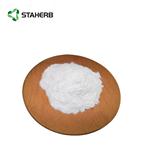Rutaecarpine also inhibits accumulation of macrophages and cholesterol in atherosclerotic lesions and increases cholesterol excretion in other animal models. Additionally, rutaecarpine inhibits hypoxia-induced production of ROS and lactate dehydrogenase and suppresses apoptosis in myocardiocytes. In other cellular models, rutaecarpine decreases corticosterone production, potentially through inhibition of cAMP, 3β-hydroxysteroid dehydrogenase, and 11β-hydroxylase activity.
Rutaecarpine is an indoloquinazoline alkaloid originally found in Evodia; it exhibits anti-inflammatory, anti-atherosclerotic, cardioprotective, anorexigenic, and anti-obesity activities. Rutaecarpine inhibits COX-2 and also decreases food intake, weight gain, and serum glucose, leptin, and insulin levels in vivo by inhibiting expression of neuropeptide Y and AgRP.
Rutaecarpine also inhibits production of ROS, NO, and iNOS, potentially through inhibition of NADPH oxidase. In macrophages, rutaecarpine inhibits arachidonic acid release and decreases production of prostaglandin E2 (PGE2); in other in vitro models, it inhibits collagen-stimulated formation of thromboxane B2 and inosine monophosphate.
![N,N''-1,6-Hexanediylbis[N',N'-dimethylurea] Structure](/CAS/GIF/20575-76-2.gif)

